On March 25, Ilie Năstase and Jimmy Connors faced off for the Equity Funding International title at Georgetown University. It was their third official meeting of the season. Counting exhibition matches, though, the number might have already reached double digits.
Duties discharged on the USLTA indoor circuit with the completion of the Georgetown event, Connors and Năstase made their way to Springfield, Massachusetts, where they played the first-ever tennis at the local Civic Center. The exhibition was set up as a mini-tournament. Connors won a pro set against veteran standout Clark Graebner, and Nastase defeated the 18-year-old amateur Vitas Gerulaitis.
The evening of March 27 concluded with a “final”–a standard set between Jimbo and the flashy Romanian for the title. They split twelve games and equally shared the first eight points of the tiebreak. Playing according to James Van Alen’s preferred “sudden death” rules, Connors double-faulted at 4-4 and handed Nastase the match.
The result didn’t really matter, just as it hadn’t mattered a week before in Whitefish Bay, Wisconsin, and it hadn’t mattered in Dallas a week before that. The Jimmy-Ilie exhibitions were always suspiciously close–8-6 in the third, 9-8 or 7-6 in a one-setter. The pair was in such demand not because of their rivalry, but because they always put on a show. They were reliably entertaining even when the stakes were higher. Early in the Georgetown final, Năstase missed a shot. Connors hollered, “Even a guy as great as you can’t make it all the time.” Ilie retorted, “If you stay around a while, I’ll teach you something.” The Romanian ultimately won the match in five.
Columnist Gerry Finn wrote of Năstase, “At one moment he’s a charmer, the next he’s a cad.” He was the biggest box-office draw in the game. Graebner said simply, “Tennis needs more Ilie Năstases.” Jimbo was studying hard for the role.
The USLTA indoor circuit was sometimes derided as a “Mickey Mouse” tour, as most of the game’s stars–Rod Laver, Stan Smith, Arthur Ashe, and others–played for the rival World Championship Tennis group. But the USLTA slate had its own perks. Players weren’t required to show up every week–an important provision for men who liked to pad their bank accounts with extracurricular activities as often as Connors and Năstase did. USLTA events were a bit more fun, too, largely because Ilie set the tone.
What appealed most to Connors was the level of play. He and his Romanian buddy could breeze through the early rounds every week. Jimmy racked up seven titles and over $36,000 in prize money in just three months. “I thought it’d be better for me to ease into it and get a little confidence,” said the 20-year-old rising star. “It’s worked out real well for me.”
Coached by Pancho Segura and urged on by Richard González, Jimbo would soon raise his sights. Once, in those early years, he told González that you can’t win them all. Gorgo’s response said all you needed to know about the veteran warrior–not to mention the man that Connors would become.
“Why not?”
* * *
This is the fourth installment in what I fear will be an ongoing series about 1973, perhaps the most consequential season in modern tennis history. Check back throughout the year for the latest news from, uh, fifty years ago.
